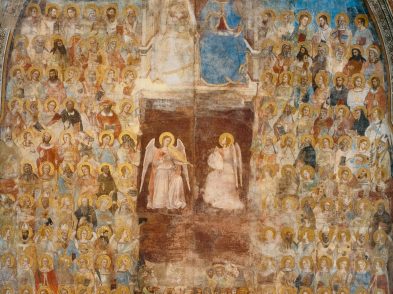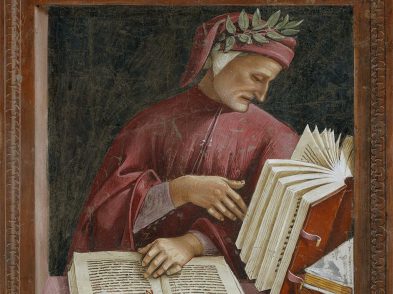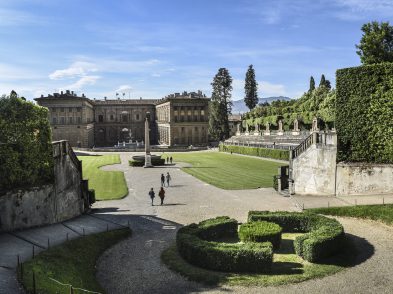No man is an
island, entire of itself; every man is a piece of the continent, a
part of the main. . . any man’s death diminishes me, because I am
involved in mankind, and therefore never send to know for whom the
bell tolls; it tolls for thee. John
Donne (1624)
Florence, May,
1498.
Lorenzo
de’ Medici is six years gone and the city is in the tight grips of
the fiery preacher Domenico Savonarola, whose passionate followers
are so emotional that they are known to sob loudly during his sermons
thus earning their nickname, piagnoni-weepers.
Nearly 50 years earlier, in 1440, the convent of San Marco-home
base for Savonarola and his weepers-had been given a bell
commissioned by Cosimo de’ Medici and designed by Leonardo’s
master, Andrea del Verrocchio. Once Savonarola took charge of the
convent, the bell was christened ‘la Piagnona,’ as its thunderous
wailing came to symbolize the friar and his followers. However, after
four years of blistering terror and one particularly nasty bonfire of
the vanities, the inherently more moderate Florentines have had it
with the Dominican priest and his piagnoni.
An angry local mob
organizes to put an end to Savonarola’s supremacy. The closer the
armed horde gets to the convent of San Marco, the more incessantly
the friars inside begin to hammer on the Piagnona in a desperate call
for help that never comes. Savonarola is captured and eventually
burned at the stake in Piazza della Signoria on May 23, 1498. La
Piagnona is taken down from the bell tower of San Marco, placed on a
cart and paraded throughout the city where Florentines whip the bell
in demonstration of their passionate hatred of the friar. In an
unconventional move, the city decides that the symbol of Savonarolan
terror itself-la Piagnona-would be put on trial. Once
‘convicted’, the bell is sent into exile at the church of San
Miniato al Monte for 50 years before being allowed back into the city
walls.
No one has heard the sound
of La Piagnona since May 1498. Until now.
Florence, October,
2010.
A small group
gathers in the cloister of Sant’Antonino in the convent of San
Marco. A bell, the Piagnona, sits in the middle of the Chapter House.
A hush falls as the rope is pulled. Wailing ensues.
La
Piagnona has come back to life thanks to a project called The Bells
of Florence, sponsored by the Friends of Florence, a non-profit
international foundation created to allow citizens of the world to
participate in the preservation and enhancement of Florence and its
surroundings. The bells project, which has at its heart the
restoration of the Piagnona, is a historic record of 28 of the city’s
major church bells, including photographs, research and recordings of
the chimes.
Anthony Sidney, a New
York-born local composer and music teacher, had been thinking of this
project for years before he proposed it to Alison Gilligan, co-chair
of the Florence Chapter of Friends of Florence, whose organization
recognized the importance of creating a permanent record of the bells
for posterity’s sake.
In January of this year,
Sidney’s 28-bell adventure began, starting with a visit to the
archdiocese for permission to record the chimes of various church
bells. Once consent was granted, he and his son, Benjamin, began
contacting each individual church to set up appointments for
recording: ‘Many of the parish priests were confused when I
approached them about “registrando,” which in the Florentine
dialect can also mean “to repair.” The older priests were
genuinely baffled at my proposition to come fix the bells!’
The bells, which will be
featured in a DVD set for release on December 6, 2010, are all
located within the city walls, with the exception of San Miniato, San
Francesco di Paola and San Domenico in Fiesole. As many churches are
currently moving towards playing recordings of their chimes, and even
fending off attempts to silence them entirely, Sidney felt that this
was a way to show his affection for these instruments-and for the
city of Florence, which he deeply loves.
Some of the tunes
included on the DVD are ones that even most locals do not normally
hear, since many of the churches only play their simplest ‘cenno’ chimes on a regular basis. One example is the church of San Frediano
in Cestello, where the priest-initially a bit protective of his
bells when Sidney came to record them-allowed the crew into the
off-limits cloister then went inside and set all the various bells
and their chimes into motion. Though most are now computerized, some,
like San Piero in Gattolino (also known as the Chiesa di Serumido) on
via Romana, are still played by hand.
During his odyssey, Sidney
made various discoveries about sizes, shapes, forms and sounds of the
historic bells, some of which have been recast numerous times or even
replaced entirely. He conducted a thorough history of each one,
including the original shapes and the foundrymen responsible for
their casting.
There is no doubt,
however, that the Piagnona is the centerpiece of the project. Cast by
Donatello and Michelozzo, Sidney maintains that these Renaissance
masters knew exactly what they were doing in terms of sound: the
copper and tin they used produce a perfection of equilibrium that
creates totally unexpected notes. Now newly restored and recorded,
the project has, as San Marco museum director Magnolia Scudieri said
the day La Piagnona rang out after 512 years, ‘brought a piece of
the 1400s back to life for present and future generations.’
For Sidney, the project is
an expression of his personal connection to the bells in a
collective, and spiritual, sense. ‘The answer to the infamous
question for whom the bell tolls is, of course, it tolls for you. It
tolls for everyone.’
The Bells of Florence DVD
features 28 historic bells, their stories, chimes and footage from
the recordings all set against a background of music composed by
Anthony Sidney especially for this project. Friends of Florence will
donate copies to the Library of Congress and major libraries in Italy
as a historical document. It will also be available to the general
public following its release on December 6, 2010.
See Anthony
Sidney’s MySpace page for details.








